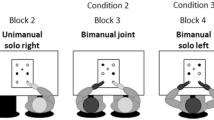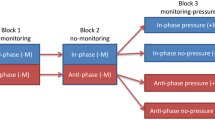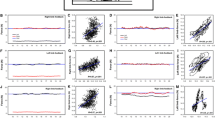Abstract
In two experiments we compared intermanual interactions in discrete and periodic movements with same and different amplitudes. In the first experiment there was only a weak amplitude assimilation in first cycles of movements with 1, 3, and 10 cycles, but a strong assimilation in later cycles. Whereas movement times of concurrent short-amplitude and long-amplitude movements were different in first cycles, in the later cycles they were essentially identical. In the second experiment the timed-response procedure was used to study the specification of same and different amplitudes of discrete reversal movements and periodic movements with three cycles. Differences in the time courses of amplitude specifications were only small. In periodic movements a dependence of amplitudes on the preparation interval was seen not only in the first cycles, but also in the later ones. However, in the later cycles the characteristic dependence of assimilation effects and intermanual correlations on the preparation interval was absent. Taken together, these findings strongly suggest that intermanual interactions arise transiently in the specification of both discrete and periodic movements, and that additional kinds of interactions become effective during execution of periodic movements.








Similar content being viewed by others
Notes
There may be concerns about the generalizeability of the findings obtained with a task which can be performed only by a certain proportion of people. Task variants of the timed-response procedure are easily of this kind. Regarding the generalizeability of the findings at least two considerations are essential. First, it is not intended to generalize performance characteristics. The very idea appears strange that performance characteristics should be generalized to the subset of the population who cannot perform the task. Instead we claim generalizeability of inferences based on the observed performance data, in particular of the inferences related to underlying mechanisms. Such mechanisms should be present even though in some people a certain task cannot be performed; in principle they should reveal their effects in other tasks as well (cf. Heuer 1988). Second, a prerequisite for this kind of generalizeability is that the selection of participants is not based on those performance characteristics which are critical for the inferences (e.g. the transient amplitude assimilation at short preparation intervals). This was clearly not the case in the present experiment.
References
Boessenkool JJ, Nijhof E.-J, Erkelens CJ (1999) Variability and correlations in bimanual pointing movements. Hum Mov Sci 18:525–552
Cattaert D, Semjen A, Summers JJ (1999) Simulating a neural cross-talk model for between-hand interference during bimanual circle drawing. Biol Cybern 81:343–358
Cohen L (1971) Synchronous bimanual movements performed by homologous and nonhomologous muscles. Percept Mot Skills 32:639–644
Deutsch D (1983) The generation of two isochronous sequences in parallel. Percept Psychophys 34:331–337
Diedrichsen J, Hazeltine E, Kennerley S, Ivry RB (2001) Moving to directly cued locations abolishes spatial interference during bimanual actions. Psychol Sci 12:493–498
Diedrichsen J, Nambisan R, Kennerley SW, Ivry RB (2004) Independent on-line control of the two hands during bimanual reaching. European Journal of Neuroscience 19:1643–1652
Franz EA, Zelaznik HN, McCabe G (1991) Spatial topological constraints in a bimanual task. Acta Psychol 77:137–151
Ghez C, Hening W, Favilla M (1990) Parallel interacting channels in the initiation and specification of motor response features. In: Jeannerod M (eds) Attention and performance XIII. Erlbaum, Hillsdale, pp 265–293
Ghez C, Favilla M, Ghilardi MF, Gordon J, Bermejo R, Pullman S (1997) Discrete and continuous planning of hand movements and isometric force trajectories. Exp Brain Res 115:217–233
Glencross DJ, Piek JP, Barrett NC (1995) The coordination of bimanual synchronous and alternating tapping sequences. J Motor Behav 27:3–15
Haken H, Kelso JAS, Bunz H (1985) A theoretical model of phase transitions in human hand movements. Biol Cybern 51:347–356
Hening W, Favilla M, Ghez C (1988) Trajectory control in targeted force impulses. V. Gradual specification of response amplitude. Exp Brain Res 71:116–128
Heuer H (1984) Binary choice reaction time as a function of the relationship between durations and forms of responses. J Motor Behav 16:392–404
Heuer H (1986) Intermanual interactions during programming of finger movements: transient effects of ‘homologous coupling’. In: Heuer H, Fromm C (eds) Generation and modulation of action patterns. Springer, Berlin Heidelberg New York, pp 87–101
Heuer H (1988) The laboratory and the world outside. In: Meijer OG, Roth K (eds) Complex movement behaviour: ’the’ motor-action controversy. North-Holland, Amsterdam, pp 405–417
Heuer H (1993) Structural constraints on bimanual movements. Psychol Res 55:83–98
Heuer H (1996) Coordination. In: Heuer H, Keele SW (Eds) Handbook of perception and action, Vol 2. Motor skills. Academic, London, pp 121–180
Heuer H, Klein W (2005) The influence of movement cues on intermanual interactions. Psychol Res (in press)
Heuer H, Schmidt RA, Ghodsian D (1995) Generalized motor programs for rapid bimanual tasks: a two-level multiplicative-rate model. Biol Cybern 73:343–356
Heuer H, Spijkers W, Kleinsorge T, van der Loo H, Steglich C (1998) The time course of cross-talk during the simultaneous specification of bimanual movement amplitudes. Exp Brain Res 118:381–392
Heuer H, Spijkers W, Kleinsorge T, Steglich C (2000) Parametrische Kopplung bei Folgen beidhändiger Umkehrbewegungen mit gleichen und unterschiedlichen Weiten. Zeitschrift für experimentelle Psychologie 47:34–49
Heuer H, Kleinsorge T, Spijkers W, Steglich C (2001) Static and phasic cross-talk effects in discrete bimanual reversal movements. J Motor Behav 33:67–85
Heuer H, Spijkers W, Steglich C, Kleinsorge T (2002) Parametric coupling and generalized decoupling revealed by concurrent and successive isometric contractions of distal muscles. Acta Psychol 111:205–242
Jeka JJ, Kelso JAS (1995) Manipulating symmetry in the coordination dynamics of human movement. J Exp Psychol Hum Percept Perform 21:360–374
Kay BA, Kelso JAS, Saltzman E, Schöner G (1987) Space-time behavior of single and bimanual rhythmical movements: data and limit cycle model. J Exp Psychol Hum Percept Perform 13:178–192
Kelso JAS (1984) Phase transitions and critical behavior in human bimanual coordination. Am J Physiol: Regulat Integrat Comp 246:R1000–R1004
Kelso JAS, Southard DL, Goodman D (1979) On the coordination of two-handed movements. J Exp Psychol: Hum Percept Perform 5:229–238
Kennerley SW, Diedrichsen J, Hazeltine E, Semjen A, Ivry RB (2002) Callosotomy patients exhibit temporal uncoupling during continuous bimanual movements. Nature Neurosci 5:376–381
Klapp ST (1979) Doing two things at once: the role of temporal compatibility. Mem Cognit 7:375–381
Klapp ST, Hill M, Tyler J, Martin Z, Jagacinski R, Jones M (1985) On marching to two different drummers: perceptual aspects of the difficulties. J Exp Psychol Hum Percept Perform 11:814–828
Marteniuk RG, MacKenzie CL, Baba DM (1984) Bimanual movement control: information processing and interaction effects. Q J Exp Psychol 36A:335–365
Mechsner F, Kerzel D, Knoblich G, Prinz W (2001) Perceptual basis of coordination. Nature 414:69–73
Monsell S (1986) Programming of complex sequences: evidence from the timing of rapid speech and other productions. In: Heuer H, Fromm C (eds) Generation and modulation of action patterns. Springer, Berlin Heidelberg New York, pp 72–86
Norrie ML (1964) Timing of two simultaneous movements of arms and legs. Res Quart 35:511–522
Norrie ML (1967) Effects of unequal distances and handedness on timing patterns for simultaneous movements of arms and legs. Res Quart 38:241–246
Rinkenauer G, Ulrich R, Wing AM (2001) Brief bimanual force pulses: correlations between the hands in force and time. J Exp Psychol Hum Percept Perform 27:1485–1497
Rosenbaum DA, Slotta JD, Vaughan J, Plamondon R (1991) Optimal movement selection. Psychol Sci 2:86–91
Rosenblum LD, Turvey MT (1988) Maintenance tendency in coordinated rhythmic movements : relative fluctuations and phase. Neuroscience 27:289–300
Schmidt RA, Zelaznik H, Hawkins B, Frank JS, Quinn JT (1979) Motor-output variability: a theory for the accuracy of rapid motor acts. Psychol Rev 86:415–451
Schmidt RA, Sherwood DE, Walter CB (1988) Rapid movements with reversals in direction: I. The control of movement time. Exp Brain Res 69:344–354
Schouten JF, Becker JAM (1967) Reaction time and accuracy. Acta Psychol 27:143–153
Semjen A, Summers JJ, Cattaert D (1995) Hand coordination in bimanual circle drawing. J Exp Psychol Hum Percept Perform 21:1139–1157
Serrien DJ, Swinnen SP (1997) Isofrequency and multifrequency coordination patterns as a function of the planes of motion. Q J Exp Psychol 50A:386–404
Sherwood DE (1990) Practice and assimilation effects in a multilimb aiming task. J Motor Behav 22:267–291
Sherwood DE (1991) Distance and location assimilation effects in rapid bimanual movement. Res Q Exerc Sport 62:302–308
Sherwood DE (1994a) Interlimb amplitude differences, spatial assimilations, and the temporal structure of rapid bimanual movements. Hum Movem Sci 13:841–860
Sherwood DE (1994b) Hand preference, practice order, and spatial assimilations in rapid bimanual movement. J Motor Behav 26:123–134
Sherwood DE (2004) Movement time modulates spatial assimilation effects in rapid bimanual movements. Res Q Exerc Sport 75:203–208
Sherwood DE, Nishimura KM (1992) EMG amplitude and spatial assimilation effects in rapid bimanual movements. Res Q Exerc Sport 63:284–291
Sherwood DE, Nishimura KM (1999) Spatial error detection and assimilation effects in rapid single and bimanual aiming movements. J Motor Behav 31:381–393
Sherwood DE, Schmidt RA, Walter CB (1988) Rapid movements with reversals in direction: II. Control of movement amplitude and inertial load. Experimental Brain Research 69:355–367
Spijkers WAC (1987) Programming of direction and velocity of an aiming movement: the effect of probability and response-specificity. Acta Psychol 65:285–304
Spijkers W, Heuer H (1995) Structural constraints on the performance of symmetrical bimanual movements with different amplitudes. Q J Exp Psychol 48A:716–740
Spijkers W, Tachmatzidis K, Debus G, Fischer M, Kausche I (1994) Temporal coordination of alternative and simultaneous aiming movements of constrained timing structure. Psychol Res/Psychol Forsch 57:20–29
Steglich C, Heuer H, Spijkers W, Kleinsorge T (1999) Bimanual coupling during the specification of isometric forces. Exp Brain Res 129:302–316
Swinnen SP, Dounskaia N, Levin O, Duysens J (2001) Constraints during bimanual coordination: the role of direction in relation to amplitude and force requirements. Behav Brain Res 123:201–218
Verwey WB, Eikelboom T (2003) Evidence for lasting sequence segmentation in the discrete sequence-production task. J Motor Behav 35:171–181
Weigelt C, Cardoso de Oliveira S (2003) Visuomotor transformations affect bimanual coupling. Exp Brain Res 148:439–450
Author information
Authors and Affiliations
Corresponding author
Additional information
This research was supported by grant He 1187/14-1 of the Deutsche Forschungsgemeinschaft. We thank Barbara Herbst, Holger Küper, and Kevin Schepers for their support in setting up and running the experiments. The paper has profited from helpful comments of Jörn Diedrichsen and an anonymous reviewer.
Rights and permissions
About this article
Cite this article
Heuer, H., Klein, W. Intermanual interactions in discrete and periodic bimanual movements with same and different amplitudes. Exp Brain Res 167, 220–237 (2005). https://doi.org/10.1007/s00221-005-0015-0
Received:
Accepted:
Published:
Issue Date:
DOI: https://doi.org/10.1007/s00221-005-0015-0




